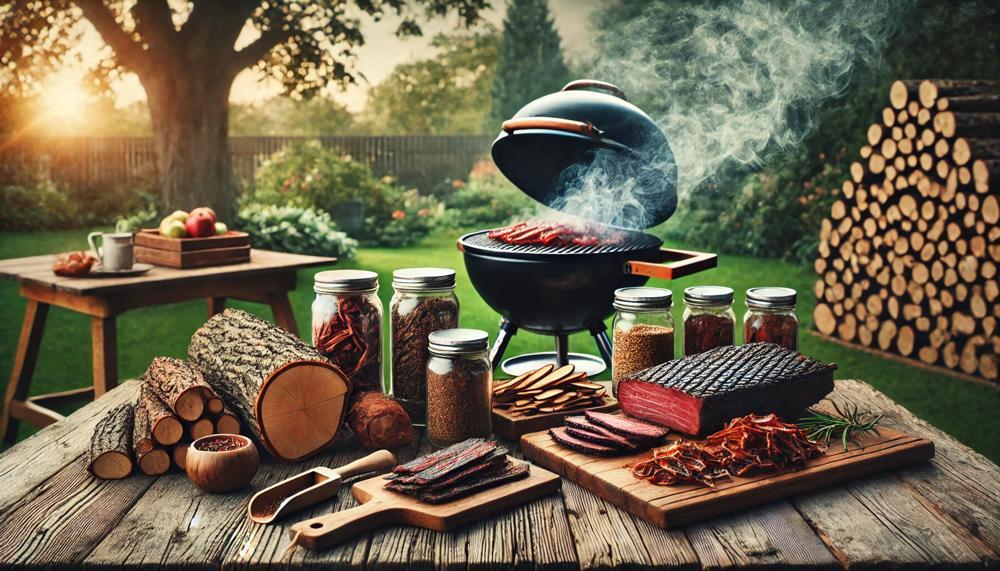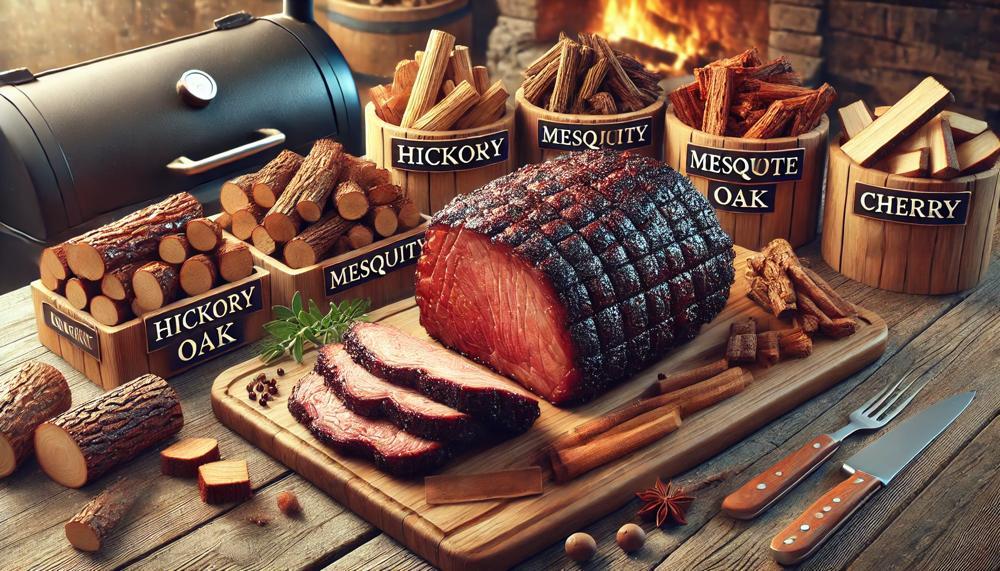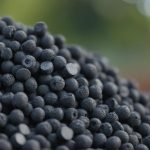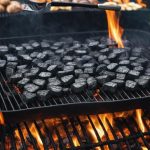When crafting beef jerky, the choice of wood used for smoking is paramount, significantly impacting both flavor and aroma. For those embarking on the jerky-making journey, here are the top contenders for achieving the perfect smoky taste:
- Hickory: Known for its strong, classic smoky flavor, hickory is the go-to for those seeking a traditional beef jerky zest.
- Apple Wood: Offers a milder, sweeter smoke that enhances the beef’s natural flavors without overwhelming them.
- Oak: Provides a medium level of smokiness, making it a versatile choice that complements rather than dominates.
- Mesquite: Ideal for a quick smoke, delivering an intense flavor suitable for those who enjoy a robust taste.
- Cherry Wood: Infuses jerky with a mild, sweet, and fruity smoke, perfect for adding a subtle complexity.
Each type of wood brings its unique profile to the jerky, allowing for a range of flavors from subtle to bold. Remember, the key is to avoid softwoods like cedar and pine, which can impart a resinous flavor not suited to dried meats.
Choosing the right wood not only enhances the taste but transforms beef jerky into a gourmet experience. Curious about how each wood influences the jerky’s flavor? Let’s delve deeper into the characteristics that make these woods the top choices for your next batch.
Contents
- 1 The Best Cuts of Beef for Smoking Jerky
- 2 Freezing Techniques for Preparing Beef Jerky
- 3 Crafting the Perfect Smoked Jerky Marinade
- 4 Time, Temperature, and Wood Selection for Smoking Jerky
- 5 Troubleshooting Common Issues With Smoked Jerky
- 6 Tips for Achieving the Perfect Texture and Storage of Jerky
- 7 Conclusion
The Best Cuts of Beef for Smoking Jerky
| Cut of Beef | Characteristics | Best Use |
| Beef Brisket | Rich flavor, tender texture | Perfect for traditional jerky with deep smoky notes |
| Chuck Roast | Flavorful and well-marbled | Makes juicy jerky with a robust beefy taste |
| Short Rib | Intense marbling, bold taste | Creates succulent jerky with a pronounced beef flavor |
| Top Sirloin | Lean and tender | Ideal for leaner jerky with a mild, beefy essence |
| Flank Steak | Lean with pronounced grain | Produces chewy jerky with a distinctive texture |
| Rump | Firm texture, rich flavor | Makes robust jerky with a meaty taste |
| Round | Very lean with slight toughness | Creates lean jerky with a hearty, beefy flavor |
When crafting delicious smoked jerky, selecting the right cut of beef is crucial. Beef brisket is a top choice due to its rich flavour and tenderness, ideal for traditional jerky with deep smoky notes. Chuck roast offers a flavorful and well-marbled option, resulting in juicy jerky with a robust beefy taste.
For a bolder flavour, short rib’s intense marbling creates succulent jerky with a pronounced beef flavour. Top sirloin, being lean and tender, is perfect for leaner jerky with a mild, beefy essence.
Flank steak, with its lean profile and pronounced grain, produces chewy jerky with a distinctive texture. Rump’s firm texture and rich flavour make it ideal for crafting robust jerky with a meaty taste.
Freezing Techniques for Preparing Beef Jerky
Freezing beef before preparing jerky offers significant benefits and when executed with precise techniques, can greatly enhance the quality and longevity of the jerky. Here’s how:
Benefits of Freezing Beef for Jerky:
- Extended Shelf Life: Freezing slows down bacterial growth significantly, thereby extending the jerky’s shelf life.
- Flavor Preservation: Cold temperatures help in locking in the flavors and freshness of the beef until it is processed into jerky.
- Waste Prevention: By freezing the beef, you can prepare and use as much as needed, reducing the risk of spoilage and waste.
Recommended Freezing Techniques:
To ensure the best quality jerky, follow these guidelines:
- Prompt Freezing: Freeze the beef as soon as possible after purchasing or preparing to maintain its freshness.
- Airtight Packaging: Use vacuum-sealed bags or airtight containers to protect the beef from freezer burn and oxidation.
- Avoid Overcrowding: Spread the beef out evenly in the freezer to allow quick and uniform freezing.
- Thawing Method: Thaw the beef gradually in the refrigerator to maintain its texture. Avoid refreezing once thawed to reduce the risk of bacterial growth.
Crafting the Perfect Smoked Jerky Marinade
To craft the perfect smoked jerky marinade, key ingredients play a pivotal role in enhancing its flavour profile. Here’s a detailed breakdown to guide your marinade creation:
| Ingredient | Role | Notes |
|---|---|---|
| Soy Sauce | Provides salty umami depth | Enhances savouriness and complexity |
| Worcestershire Sauce | Adds tanginess and depth | Complements meaty richness |
| Liquid Smoke | Infuses smoky flavour without a smoker | Creates a rich, authentic smoked taste |
| Brown Sugar | Brings sweetness and caramelisation | Balances savoury elements |
| Garlic Powder | Provides robust, aromatic flavour | Enhances overall depth |
| Onion Powder | Adds savoury sweetness | Complements garlic and meat flavours |
| Black Pepper | Provides mild heat and earthiness | Adds a subtle kick |
| Apple Cider Vinegar | Introduces fruity tang | Enhances marinade complexity |
| Teriyaki Sauce | Offers sweet-salty balance | Brings Asian-inspired flavour |
| Hot Sauce | Provides spicy heat | Adjust to desired heat level |
| Cayenne Pepper / Crushed Red Pepper Flakes | Boosts spiciness | Add gradually to control heat |
| Herbs and Spices (e.g., Paprika, Cumin) | Enhance flavour complexity | Experiment with different blends |
These ingredients work in harmony to create a balanced marinade that elevates your jerky’s taste. Experiment with quantities to achieve your desired flavour intensity. Marinate for at least 8 hours to overnight for optimal results.
Adjust sweetness, saltiness, and spiciness to suit your preferences, ensuring each bite is packed with deliciousness.
Time, Temperature, and Wood Selection for Smoking Jerky
Time, temperature, and wood selection are pivotal when smoking jerky to achieve that perfectly preserved, flavourful chew. Here’s a concise guide:
Recommended Time and Temperature Settings:
For optimal results, smoking jerky requires precise control of temperature and timing. Maintaining a low temperature is essential to dehydrate the meat gently without cooking it through, which preserves its texture and taste. Typically, the sweet spot for smoking jerky is within a temperature range of 165°F (74°C) to 180°F (82°C). This range helps in slowly extracting moisture while ensuring the meat remains tender and not overly dry or tough.
The duration for smoking jerky usually ranges from 4 to 6 hours. However, this can vary based on the thickness of the meat slices and desired dryness. It’s crucial to monitor the process closely, as slight variations in thickness can alter drying times significantly.
Impact of Wood Selection on Flavor:
Choosing the right wood for smoking jerky can significantly influence its flavour profile. Each wood variety imparts a unique essence that can elevate the jerky from merely tasty to extraordinarily delectable. Here’s how different woods can affect the taste:
- Hickory imparts a strong, smoky flavour, ideal for those who enjoy bold tastes.
- Mesquite, with its intense earthy notes, is perfect for a robust flavour kick.
- Applewood offers a sweeter, milder smoke, enhancing the jerky with subtle, fruity undertones.
Troubleshooting Common Issues With Smoked Jerky
Troubleshooting common issues with smoked jerky often leads us to the twin culprits of dryness and toughness. Here’s a direct approach to understanding and rectifying these mishaps.
Why Jerky Turns Dry or Tough
Jerky can end up overly dry or excessively tough due to a few key factors:
- Incorrect Meat Selection: Lean meats work best as they contain less fat, which can cause rancidity.
- Slicing Technique: Meat should be sliced against the grain to ensure tenderness.
- Overcooking: Excessive cooking time or too high a temperature dries out the meat.
- High Smoking Temperature: Ideal smoking temperature should be between 165°F and 180°F. Higher temperatures cook out the moisture too rapidly.
How to Fix Dry or Tough Jerky
| Problem | Reason | Solution |
| Dry Jerky | Overcooked or high temperature | Rehydrate by applying liquids like Worcestershire sauce or broth, then seal in a bag for up to 24 hours. |
| Tough Jerky | Incorrect meat cut or sliced incorrectly | Allow jerky to cool completely then store in an air-tight container for a few days to improve texture. |
Rehydration Tips: If your jerky has turned out too dry, consider rehydrating it. This involves lightly coating the jerky in a liquid such as Worcestershire sauce, broth, or even plain water. Place the moistened jerky in a zip-lock bag, seal it, and let it sit in the refrigerator for up to 24 hours. Be cautious not to introduce too much moisture, as this can spoil the jerky.

For those struggling with tough jerky, ensure that the meat cools on a rack before storage. This stops the cooking process and preserves the meat’s chewable texture. Store it in an air-tight container to slightly soften the jerky, making it less tough.
In practice, consistently monitoring your smoking process, from meat selection and preparation to cooking time and temperature, can significantly enhance your jerky’s quality. Remember, a little tweak can make a big difference.
Tips for Achieving the Perfect Texture and Storage of Jerky
To maintain the perfect texture and flavor of jerky over time, it’s crucial to store it appropriately. Here’s a structured approach based on different storage durations and conditions:
Short-term Storage (Up to 1 Week):
- Container: Use a paper bag to allow slight air circulation.
- Environment: Store in a cool, dark, and dry place such as a pantry.
Medium-term Storage (Up to 2 Months):
- Container: Store in an airtight container to protect against moisture and contaminants.
- Environment: Keep the container in a dry cupboard away from heat and light.
Long-term Storage (Up to 2 Years):
- Container: Vacuum-sealed bags provide the best protection by removing air exposure and reducing oxidation.
- Environment: For room temperature storage (up to 3 months), keep in a dark, dry place. For extended storage (up to 2 years), freeze the vacuum-sealed jerky.
Conclusion
Choosing the best wood for smoking beef jerky can make or break your culinary endeavor, significantly influencing its flavor and aroma. Each type of wood brings distinct characteristics to the table:
Hickory, renowned for its robust smokiness, offers a classic flavor ideal for traditionalists seeking a deep, bold taste in their jerky. Apple wood provides a sweeter, milder smoke that enhances the natural flavors of the beef without overpowering them, making it perfect for those preferring a subtle touch. Oak strikes a balance with a medium smokiness that complements rather than dominates, suitable for a versatile jerky experience. Mesquite, on the other hand, delivers an intense, robust smoke quickly, appealing to aficionados of strong flavors. Cherry wood adds a mild, fruity sweetness that subtly enhances the jerky, offering a complex yet delicate profile.
When selecting your smoking wood, avoid softwoods like cedar or pine, as these can impart undesirable resinous flavors. By choosing the right wood type based on your flavor preferences, you can elevate your beef jerky from ordinary to extraordinary, transforming each bite into a savory adventure.






